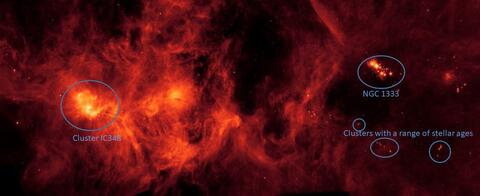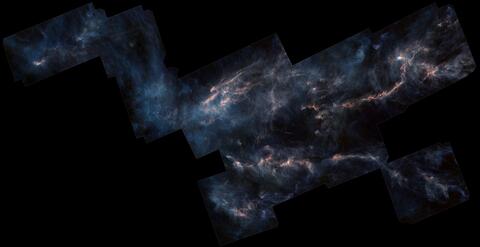You can now hold a supernova cavity and the molecular clouds around it in your hands!
Using a 3D visualisation tool, researchers have demonstrated that the “Perseus-Taurus Supershell” was caused by a supernova 10 million years ago, and that this event precipitated star-formation in nearby molecular clouds.
Previous articles have highlighted the difficulties that researchers face in painting a clear picture of the process of star formation: from citizen science projects to the Starforge simulation, many resources are put into this quest. The new technology used to determine the origins of the Perseus-Taurus cavity in our galaxy is a revolutionary one that will even have applications in other fields too. In the past, 2D maps of the Milky Way’s stars have been made, but the 3D version clearly shows that there is a kind of bubble-shape void among these stars. Using a software named “Glue” with the most recent data released by the European Space Agency from their Gaia satellite, astronomers from the Institute for Theory and Computation at the Centre for Astrophysics got a result that’s not just a simulation, but a visualisation of what’s actually out there in the Milky Way.
What they discovered is that the Perseus and Taurus molecular clouds are in fact found along one single giant structure that formed due to a supernova explosion some 10 million years ago. Until now, it was impossible to determine whether the spherical void arose because of a single supernova event or a series thereof. This cavity, which as suggested above is located among the constellations of Perseus and Taurus, is a region of space that was “emptied” by the supernova’s shockwave, but what’s more this triggered a chain reaction as a consequence of which we find the two molecular clouds.

Perseus Molecular Cloud as seen by the Spitzer Space Telescope 
Combined images of Taurus Molecular Cloud as seen by the Herschel Space Observatory
The way this links back to star formation is that such molecular clouds are the birthplaces of stars. The Taurus one is of particular interest to astronomers as it’s located only 430 light-years away, which makes it one of the closest large star-forming regions – young stars which are just 1 or 2 million years old have been observed there, suggesting the aforementioned chain of events works quite rapidly (in astronomical terms). The Perseus cloud is on the other side of the cavity which places it some 1000 light-years away, but what also makes it harder to observe is the fact that as a giant molecular cloud containing 10 000 solar masses of gas and dust, the dust hides the proto-stars, which makes it almost invisible at … visible wavelengths, ironically. With the new visualisation though, astronomers are able to grasp how the star-forming regions themselves form out of the complex environment that is the interstellar medium.
This publication is even more significant due to the fact that all the data is available to the public, including a format that can be viewed in augmented reality using a “Merge Cube”. This $15 (£11) foam cube, used with an associated app or even Virtual Reality glasses, allows you to hold the Perseus-Taurus Supershell in your own hands and to look at it from every direction!
The authors of this study expect this type of research output with enhanced visuals and possibly even audio material to become increasingly common to help both scientists and the general public apprehend the Universe, a very exciting prospect for any space enthusiast.
Cover Image: Per-Tau cavity, A. Goodman/Center for Astrophysics | Harvard & Smithsonian
Image Credits:
1 - Fig. 5 from "The Per-Tau Shell: A Giant Star-forming Spherical Shell Revealed by 3D Dust Observations", S. Baly et al., 2021
2 - Perseus, NASA/JPL-Caltech
3 - Taurus, ESA/Herschel/NASA/JPL-Caltech; acknowledgement: R. Hurt
4 - Taurus 3D Structure, Zucker et al., 2021
5 - Merge Cube (Youtube), A. Goodman/C. Zucker/Center for Astrophysics | Harvard & Smithsonian
